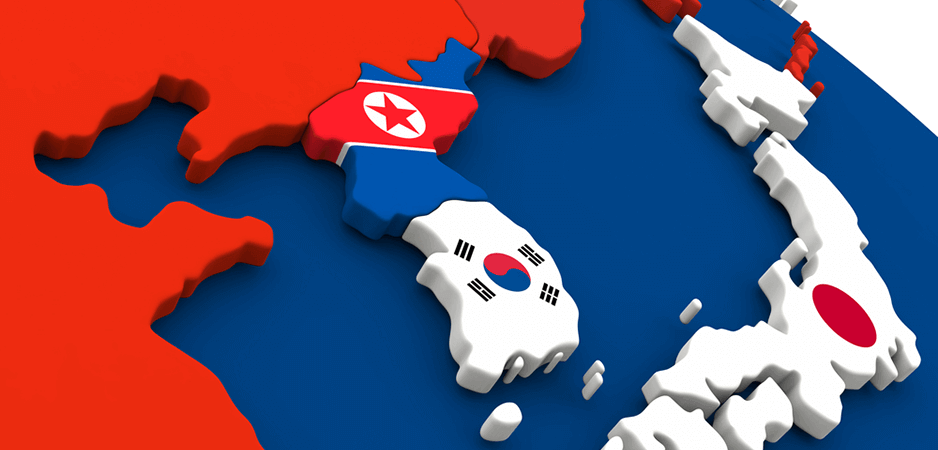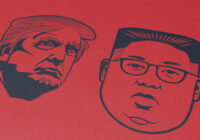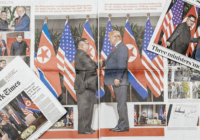Careful Korean diplomacy, coupled by Trump’s desire to do what Obama couldn’t, could mean a rapprochement on the Korean Peninsula no one thought possible.
In geopolitics, everything is impossible — until, suddenly, it isn‘t. Wars that no one ever believed could happen flare into existence, and stable societies descend into chaos. On the other side of spectrum, peace agreements that only Pollyannas thought possible are suddenly on the table after months of secret talks, as wicked problems untangle themselves and bitter enemies clasp hands.
If politics is the art of the possible, geopolitics is the tectonics of the impossible. Huge plates of rock shift, with little if any warning. Leaders topple, borders move and trade flows in different directions, sending journalists scrambling for seismic metaphors (earthquake, aftershock).
Take the case of Korea, which has been locked in a cold war for 75 years. Few observers expected anything to change with the elevation of Kim Jong-un in Pyongyang or the election of Donald Trump in the United States. Or, if there was going to be a change, it would be for the worse: a raining down of fire and fury on both sides.
And yet voila, the peninsula is now on the verge of the impossible.
On April 20, North Korea announced that it would stop testing nuclear weapons and long-range missiles. It would also shut down its nuclear test site at Punggye-ri. As an aside to a South Korean interlocutor, the North Koreans also declared that they wouldn’t demand the departure of US troops from the peninsula as part of any peace settlement.
This week, the leaders of North and South Korea will be meeting just south of the Demilitarized Zone. On the agenda: putting an official end to the Korean War, planning new realms of cooperation and committing to a denuclearized peninsula. Cue the soundtrack to Man of La Mancha: Reunification no longer seems quite such an impossible dream.
Finally, in the least likely element of the trifecta, an unprecedented summit between the leaders of the US and North Korea is scheduled for some time within the next two months. The head of the CIA, Mike Pompeo, has already slipped in and out of Pyongyang, under the radar, to start making preparations for the meeting.
The impossible hasn’t happened quite yet. Skeptics have dismissed North Korea’s announcements. The degree of cooperation between North and South is constrained by the current regime of economic sanctions. Trump could decide to nix the summit or, if it goes forward, throw an unscripted tantrum that abruptly sends everything careening backwards.
And then there are the other stubborn realities that cling to the Korean Peninsula: the importance of a nuclear deterrent for Pyongyang, the stark economic gap between North and South, and the decades of animosity that make détente between the US and its longest standing adversary so difficult to achieve.
Still, for better or worse, the impossible happens practically every day in the world of geopolitics. The only rule that applies, particularly in this Trumpian era, is: expect the unexpected.
Getting to Yes
To prove your credibility as a North Korea expert, you must pooh-pooh everything that Pyongyang says. Generally this is a safe bet, since the North Korean government spouts all sorts of propaganda. But that doesn’t mean that everything it says is nonsense.
Take the recent announcement of the nuclear test suspension. As a number of skeptics point out, the North Korean government wasn’t really saying anything radically new. It had already declared in March its willingness to maintain a moratorium on testing in anticipation of a meeting with the US president. As for the test site that it was shutting down at Punggye-ri, it had sustained considerable damage after the sixth nuclear test back in September 2017.
All of that is true — with some caveats.
Let’s start with the test site. Yes, the last nuclear test set off several small earthquakes and a number of tunnels at the site collapsed. But as 38North points out, “there is no basis to conclude that the Punggye-ri nuclear test site is no longer viable for future nuclear testing. There remain two portal areas located in more pristine competent rock that can be used for future tests if Pyongyang were to give the order.” (By the way, North Korea hasn’t been using any other site for its nuclear tests.)
As for the moratorium on testing, “This is not a denuclearization statement,” observes former National Security Council member Victor Cha. “It is a statement that DPRK [North Korea] can be a responsible nuclear weapons state.”
 That’s true, too. But what exactly did Korean experts expect? That North Korea would unilaterally disarm before a meeting with Trump? And what exactly has the US announced in the run-up to the meeting? Most Korea experts have argued that having a meeting with the North is itself a concession (oh, how diplomacy’s reputation has fallen over the years).
That’s true, too. But what exactly did Korean experts expect? That North Korea would unilaterally disarm before a meeting with Trump? And what exactly has the US announced in the run-up to the meeting? Most Korea experts have argued that having a meeting with the North is itself a concession (oh, how diplomacy’s reputation has fallen over the years).
Meanwhile, the announcement by the Worker’s Party in a resolution — “We will discontinue nuclear test and inter-continental ballistic rocket test-fire from April 21” — is not just a suspension in exchange for talks. It’s an institutional declaration without time limit. In other words, Pyongyang didn’t make its discontinuation of testing contingent on anything else. Granted, it can be reversed. But it’s still an important signal of willingness to negotiate.
Nuclear disarmament, naturally, is another matter entirely.
At this point, North Korea is holding on to its nuclear program as a “treasured sword.” Perhaps it will be willing to sign an agreement supporting eventual denuclearization. But, like St. Augustine who famously declared, “Give me chastity … but not yet,” North Korea will likely embrace the concept of nuclear disarmament before it accepts the reality of it.
After all, nuclear weapons are a strong deterrent against any possible attack (which North Korea fears). They confer enormous status at a global level (which North Korea craves). And they represent a considerable individual accomplishment for Kim Jong-un (in the absence of any other major achievements). That’s some powerful mojo.
So, I’m not expecting a major tectonic shift at the Trump-Kim summit. Maybe the two sides can move toward a peace agreement to replace the armistice that ended the Korean War. Maybe Kim will win an invitation to watch the North Korean-style military parade in Washington in the fall. Maybe Ivanka Trump will win permission to sell her baubles in Pyongyang.
But the most likely positive outcome of the summit would be an agreement to keep talking — and talking and talking until everyone runs out the clock on the Trump administration (and that ticking bomb of a national security advisor, John Bolton). Thus does the geopolitics of impossible fade into the more routine politics of the possible.
But like I said, the future could hold a surprise. Donald Trump, after all, is desperate to prove that he’s not the worst president of all time by negotiating precisely the agreement that eluded all of his recent predecessors. Trump doesn’t care about diplomacy or North Korea. He only wants to one-up Barack Obama.
Meanwhile, let’s not fall into the trap of believing that whatever involves Donald Trump is the most important event of all.
The Two Koreas
Kim Jong-un started the ball rolling at the beginning of the year when he reached out to South Korean President Moon Jae-in to cooperate on the PyeongChang Winter Olympics. But the sea change really began in 2017 with Moon’s election on a platform to reverse the previous decade of largely hostile relations between Seoul and Pyongyang.
One year into his five-year term, Moon maintains a nearly 70% popularity rating, outpolling all previous presidents at this juncture. He has also scheduled an inter-Korean summit early in his tenure — as opposed to past leaders Kim Dae-jung or Roh Moo-hyun. That means he has plenty of time and political capital to translate summit declarations into concrete policies.
The two Koreas have flirted with the impossibility of reunification twice since the end of the Korean War.
In the 1970s, when the socioeconomic gap between the two countries was slight, the dictator of the North, Kim Il-sung, and the dictator of the South, Park Chung-hee, attempted to work out a formula for political reunification that got bogged down over issues of representation (having to do with the two-to-one population advantage the South has over the North).
 In the 2000s, the South Korean presidential tag-team of Kim Dae-jung and Roh Moo-hyun together attempted a slow-motion reunification designed to gradually overcome the growing economic disparity between the two countries. That program ran up against a domestic conservative backlash, considerable US indifference, and some North Korean intransigence.
In the 2000s, the South Korean presidential tag-team of Kim Dae-jung and Roh Moo-hyun together attempted a slow-motion reunification designed to gradually overcome the growing economic disparity between the two countries. That program ran up against a domestic conservative backlash, considerable US indifference, and some North Korean intransigence.
Three times lucky? For Moon Jae-in to succeed where his predecessors failed, he should pursue three principles:
1) Quid pro quo: the South can’t simply buy the North’s participation (as Kim Dae-jung initially tried). For this third attempt at a reunification policy to work, it must have something in it for the South as well. The Kaesong Industrial Complex serves as a model for this kind of equitable approach. The South Korean companies that set up in the industrial zone just north of the DMZ provided jobs and training to tens of thousands of North Korean workers as well as a cut of pie for the North Korean government. In exchange, South Korean companies took advantage of cheaper labor so that they could effectively compete against comparable companies in China.
2) Bipartisan support: The ostpolitik of West Germany succeeded in part because virtually all political parties embraced it, from the Social Democrats to the Christian Democrats to the Christian Social Union further to the right. In South Korea, engagement policies have become associated with the liberal-left. But it doesn’t have to be this way. Moon has already found a way to give his nordpolitik wider appeal through his Olympic overtures. But he must go further to bring conservative politicians into the consultation process so that this latest round of discussions with the North is a bipartisan affair. In this way, even if a conservative wins the next presidential election, the policy can continue.
3) Internationalize: Koreans should, of course, decide their own future, together. But as in Germany, reunification should be nested within concentric regional and international rings. A unifying Germany required both a 2-plus-4 arrangement (the two Germanies plus the post-World War II occupying powers) and the welcoming embrace of the European Union. A peace treaty to replace the armistice will serve as a Korean substitute for the 2-plus-4. Another useful model is the Iran nuclear agreement with its several international signatories.
But Korean steps toward peace, denuclearization and reunification also should have substantial civil society buy-in from groups in South Korea, their counterparts in East Asia, and likeminded groups in Europe and North America. Such groups can put pressure on their respective governments to abide by commitments and also help ensure that Koreans don’t turn their gaze exclusively inward.
Of course, none of this might come to pass. Seismologists are not known for their precise predictions. But after so many years of waiting for a break, Koreans are palpably excited right now. Instead of throwing cold water on their hopes and dreams, let’s prepare to dance with them in the middle of the earthquake.
*[This article was originally published by FPIF.]
The views expressed in this article are the author’s own and do not necessarily reflect Fair Observer’s editorial policy.
Photo Credit: Harvepino / Shutterstock.com
Support Fair Observer
We rely on your support for our independence, diversity and quality.
For more than 10 years, Fair Observer has been free, fair and independent. No billionaire owns us, no advertisers control us. We are a reader-supported nonprofit. Unlike many other publications, we keep our content free for readers regardless of where they live or whether they can afford to pay. We have no paywalls and no ads.
In the post-truth era of fake news, echo chambers and filter bubbles, we publish a plurality of perspectives from around the world. Anyone can publish with us, but everyone goes through a rigorous editorial process. So, you get fact-checked, well-reasoned content instead of noise.
We publish 2,500+ voices from 90+ countries. We also conduct education and training programs
on subjects ranging from digital media and journalism to writing and critical thinking. This
doesn’t come cheap. Servers, editors, trainers and web developers cost
money.
Please consider supporting us on a regular basis as a recurring donor or a
sustaining member.
Will you support FO’s journalism?
We rely on your support for our independence, diversity and quality.






